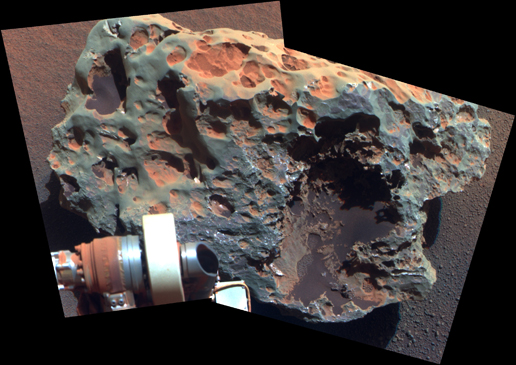Meteorites bring many things to Earth. Now a new one has joined the list: Panguite [1] an entirely new mineral, found nowhere on Earth. Panguite is a unique form of titanium dioxide, and its structure includes scandium, aluminium, magnesium, zirconium, and calcium as well.
So.... a mineral from space, that doesn't exist anywhere on Earth...cue the X-files theme tune?
So.... a mineral from space, that doesn't exist anywhere on Earth...cue the X-files theme tune?
Video above: You're a child of the nineties if you whistle this sarcastically upon hearing someone declare their 'psychic powers'. Although being able to whistle in a sarcastic tone of voice is pretty X-files in itself....
Well...I doubt Mulder and Skully got out of bed for less than an invasion by black alien goo. But more importantly, this is really just confirmation of something that we already knew: That the alien worlds these rocks formed on were alien - sometimes even in the chemistry of their rocks. Because Panguite is not the first material to be found only in a rock from space...
Here are just a few examples:
Image right: A cut and polished section of nickel-iron meteorite, showing the 'octahedrite' texture of the metal inside.
These were first found by the English Geologist W.G.Thompson, who noticed the bizarre triangular patterns forming on the surface of a Krasnojarsk meteorite [3], when he tried cleaning it with nitric acid. By the way, cleaning things with concentrated acid, of any kind, is a bad idea. Although if you can take one whiff of concentrated acid, and not realise it's best left well alone.... heaven help you, because natural selection certainly won't.
Most nickel-iron meteorites have this unique crystal pattern, which only occurs when molten nickel and iron cool together over millions of years, in microgravity - evidence that these rocks formed in the cores of objects that were no bigger than large asteroids, and yet had an internal heat source that was long lived. The cores of protoplanets are thought to be partly preserved in the M-class asteroids, which were blasted into space when their protoplanets were destroyed in massive collisions.
Meteorites discovered on the surface of Mars [4], by the Opportunity rover, have been identified by finding this crystal pattern in them.
Image above: A false-colour view of a meteorite on the Martian desert surface, named 'block island'. The image was taken by the Opportunity Mars rover [5], which was given a warranty of ninety days, and is still going eight years later. And people say NASA's lost it! I hope someone's boss is buying them regular beers for that little bit of engineering, I really, really, do. Image courtesy of JPL/NASA.
Found in the Onello meteorite [7], Allabogdenite is compound of Iron, Nickel, Cobalt and phosphorous. It's light yellow to cream in colour, and occurs as thin crystal layers. It's similar to steel in hardness, and very brittle.
A compound if titanium, iron, nickel, and phosphorous, Florenskyite is one of only four naturally occurring phosphides, and exists, as far as we know, only in the Kaidun [9] meteorite
Another from the weird Kaidum meteorite, this one based on titanium, vanadium, chromium, iron, cobalt, nickel, and phosphorous. So, everything including the kitchen sink, and the garden table, is in there.
Image above: A projected 3d structure, used to understand the structure of quasi-crystals. What you're actually looking at here is a three dimensional 'slice' through a six dimensional 'cube' or hexacube. See? I told you this stuff was weird. Image courtesy of Wikimedia commons
Don't stare too long, you'll get a headache, and start to feel like you're falling into the screen...
This really is odd stuff: Quasi-crystals are a form of matter that has an order, but no translational symmetry [12].
Its crystal pattern never repeats, making each part of the structure
unique. The discovery of quasi-crystals led to new advanced materials, and changed our understanding of how nature builds
ordered structures.
But when materials scientist Dan Shechtman first reported it in 1982, he was ridiculed, and accused of 'quasi-science'. Nearly thirty years later, in 2009, the first, and so far only natural quasi-crystal [13] was discovered, in rocks that isotope analysis [14] suggest is from an ancient asteroid impact. Shechtman, I'm happy to say, was awarded the Nobel prize [15] for chemistry shortly afterwards.
So, what is the significance of this bunch of cosmic misfits? Well, they all come from meteorites that were fairly untouched since the solar systems birth. So they tell us that, four and a half billion years ago, in the molten cores of protoplanets, nature smelted things into existence that are alien to terrestrial geology. That gives us a signpost - that the bodies these meteorites came from were genuinely different to Earth, right down to their cores - and so we need to be careful about making assumptions on how these worlds worked..
It's also a brilliant reminder: That we don't know it all, that how things are here on Earth certainly isn't how they are everywhere. And that, as we go into space, we will be visiting places where even the rocks are strange....
List of links:
[1]http://ammin.geoscienceworld.org/content/97/7/1219.full?ijkey=G2n1UMXmu7r4.&keytype=ref&siteid=gsammin
[2]http://en.wikipedia.org/wiki/Widmanst%C3%A4tten_pattern
[3]http://www.nhm.ac.uk/nature-online/virtual-wonders/vrmeteorite.html
[4]http://www.lpi.usra.edu/meetings/lpsc2010/pdf/1791.pdf
[5]http://marsrovers.jpl.nasa.gov/home/index.html
[6]http://ammin.geoscienceworld.org/content/87/8-9/1245.abstract
[7]http://www.lpi.usra.edu/meteor
[8]http://ammin.geoscienceworld.org/content/85/7-8/1082.abstract
[9]http://www.psrd.hawaii.edu/Oct09/Kaidun_meteorite.html/metbull.php?code=18020
[10]http://ammin.geoscienceworld.org/content/93/8-9/1295.abstract
[11]http://en.wikipedia.org/wiki/Quasicrystal
[12]http://classes.yale.edu/fractals/IntroToFrac/SelfSim/Symmetry/TransSymmetry.html
[13]http://news.discovery.com/space/russian-quasicrystals-might-come-from-space-120112.html
[14]ttp://www.princeton.edu/main/news/archive/S32/64/02A32/index.xml?section=topstories
[15]http://www.nobelprize.org/nobel_prizes/chemistry/laureates/2011/press.html



No comments:
Post a Comment